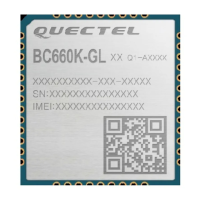NB-IoT Module Series
BC660K-GL Hardware Design
BC660K-GL_Hardware_Design 20 / 57
Table 5: Application Processor (AP) Operating Modes
Table 6: Modem Operating Modes
Table 7: Module Operating Modes
3.4. Power Saving
3.4.1. Light Sleep
In Light Sleep mode, the UART serial port does not work, and the module can be woken up on the falling
In normal mode, the AP handles tasks such as AT command communication.
When all tasks are suspended, the AP enters idle mode.
The network is connected and the module supports data transmission. In such a case,
the modem can switch to DRX/eDRX mode.
The modem is in idle mode, and downlink data can be received during PTW only. In
such a case, the modem can switch to PSM or connected mode.
In power saving mode, the modem is disconnected from the network and cannot
receive any downlink data. In such a case, the modem can switch to eDRX/DRX mode,
then quickly switch to Connected mode.
When the AP is in normal mode and the modem is in connected mode, the module is
active and supports all services and functions.
The current consumption in active mode is higher than that in sleep modes.
Generally, when the AP is in idle mode and the modem is not in PSM mode, the module
enters Light Sleep mode.
In Light Sleep mode, the current consumption of the module is reduced greatly.
When the AP is in idle mode and the modem is in PSM, the module enters Deep Sleep
mode in which the CPU is powered off and only the 32 kHz RTC clock keeps working.
In Deep Sleep mode, the current consumption is minimized (typical value: 800 nA).

